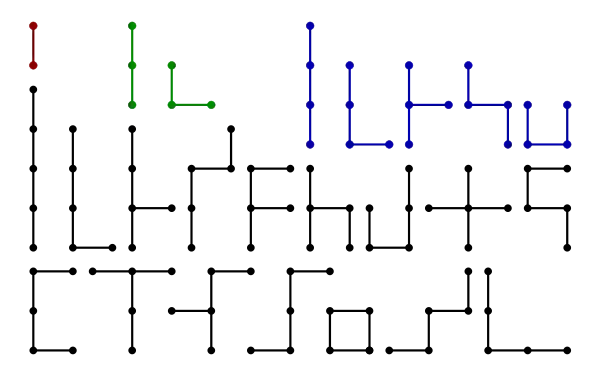Polystick
In recreational mathematics, a polystick (or polyedge) is a polyform with a line segment (a 'stick') as the basic shape. A polystick is a connected set of segments in a regular grid. A square polystick is a connected subset of a regular square grid. A triangular polystick is a connected subset of a regular triangular grid. Polysticks are classified according to how many line segments they contain.[1]
When reflections are considered distinct we have the one-sided polysticks. When rotations and reflections are not considered to be distinct shapes, we have the free polysticks. Thus, for example, there are 7 one-sided square tristicks because two of the five shapes have left and right versions.[2][3]
|
Square Polysticks | |||
| Sticks | Name | Free | One-Sided |
|---|---|---|---|
| 1 | monostick | 1 | 1 |
| 2 | distick | 2 | 2 |
| 3 | tristick | 5 | 7 |
| 4 | tetrastick | 16 | 25 |
| 5 | pentastick | 55 | 99 |
| 6 | hexastick | 222 | 416 |
| 7 | heptastick | 950 | 1854 |
|
Triangular Polysticks | ||
| Sticks | Name | Free |
|---|---|---|
| 1 | monostick | 1 |
| 2 | distick | 3 |
| 3 | tristick | 12 |
| 4 | tetrastick | 60 |
| 5 | pentastick | 375 |
| 6 | hexastick | 2613 |
| 7 | heptastick | 19074 |
The set of n-sticks that contain no closed loops is equivalent, with some duplications, to the set of (n+1)-ominos, as each vertex at the end of every line segment can be replaced with a single square of a polyomino. In general, an n-stick with m loops is equivalent to a (n−m+1)-omino (as each loop means that one line segment does not add a vertex to the figure).
Diagram
